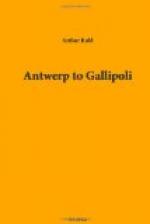The aristocracy had been wiped out before Bulgaria got her autonomy in 1878, and, unlike Rumania, where the greater portion of the land is in the hand of large proprietors, Bulgaria is a country of small farmers, of shepherds, peasants, each with his little piece of land. The men who now direct its fortunes are the sons and grandsons of very simple people. Possibly it is because we Americans are also a new people, with still some of the prejudices of pioneers, that we are likely to feel something in common with the people of this “peasant state.” They seemed to me, at any rate, the most “American” of the Balkan peoples.
There is, of course, one concrete reason for this: Robert College and the American School for Girls (Constantinople College) at Constantinople. It was men educated at Robert College who became the leaders of modern Bulgaria. The only Bulgarian I had known before—I met him on the steamer—had gone from a little village near Sofia to Harvard. His married sister had learned English at the American School for Girls; her husband, a Macedonian Bulgar, had worked his way through Yale. The amiable old general, who was always in the library at the Sofia Club at tea time, ready to tell how the Dardanelles and Constantinople could be taken, had learned English at Robert College and had a son there; the photographer who developed my films also had a son there—and so on.
Snow-capped mountains rise just behind Sofia, and the brown hills thereabout, like the rolling plateaus along the shoulders of which the train crawls on the way down from Rumania, are speckled with sheep. Sometimes even in Sofia you will meet a shepherd patiently urging his little flock up a modern concrete sidewalk and stopping now and then for some passer-by to pick up a lamb, “heft” it, poke it, and feel its wool before deciding whether or not he should take it home for dinner.
These shepherds wear roomy, short box-coats of sheepskin, with the leather outside and the wool turned in, like a motor-coat; homespun breeches embroidered, very likely in blue, and laced from the knee down, and a sort of moccasin or laced soft shoe. They are as common in the streets of Sofia as are the over-barbered young snipes in the streets of Bucarest. On market days the main down-town street is filled with them— long-limbed, slow-moving old fellows, with eyes and foreheads wrinkled from years of squinting in the bright plateau sun, faces bronzed and weathered like an old farmhouse, shuffling down the pavement and into and out of shops with the slow, soft-footed gait of so many elk. And if you were designing a stamp for Bulgaria you might well put one of these hard-headed old countrymen on it, just as in the other capital you would put the girl in the victoria pattering down the asphalt.
Two newspaper correspondents of the more or less continuous string that were filing from one Bulgarian leader to another to find out what Bulgaria was going to do, amiably permitted me to trail about with them, and thus to see and talk a little with some of those who are steering Bulgaria’s exceedingly delicate course—men whose grandfathers very likely wore those sheepskin coats with the wool turned in.




